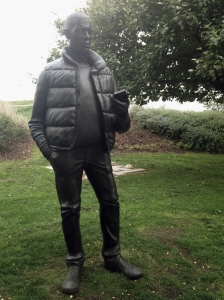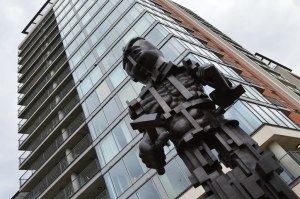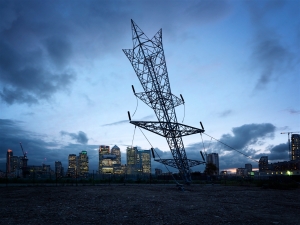Viccy Ibbett, Public Catalogue Foundation Volunteer, has been walking ‘The Line’ and gives us her account of the fascinating contemporary sculpture on the Greenwich Meridian:
‘The Prime Meridian, or zero degrees longitude, or the Greenwich meridian, has long generated a mystic attraction to the area around the Greenwich Peninsula, where the Greenwich Observatory still stands. By international convention, the Greenwich meridian was chosen in 1884 to be the standard point of measurement for longitude and, by extension, international time zones. Greenwich, by dint of this association, is a place where Time itself seems to disintegrate: it is no longer the unassailable march of successive days or seasons, authoritatively documented by the hands of innumerable clocks; it is a constructed, arbitrary, mathematical solution, wedded to human history and ingenuity. Today, if you visit the area after dark, you’ll see that the sky is split in two by a green laser that demarcates East from West, the work of artists Peter Fink and Anne Bean. On the ground, due to the spectacular efforts of several artists, developers and dedicated local volunteers, you’ll find a treasure-trove of contemporary public sculptures and art projects, which document the Now at the international epicentre of Time itself.
Working my way south from Stratford, along the River Ley to Greenwich North, here are my top five public sculptures from along the Meridian. Most of my choices are featured on The Line, a sculpture walk conceived of by the Turner prize-winning artist, Mark Wallinger, famous in particular for his work, Ecce Homo, which stood on the fourth plinth in Trafalgar Square.
1. Network, Thomas J. Price, 2013
 This large-scale bronze dominates the entrance to the Lee Valley Park, which nestles on the banks of a tributary of the Lee River. The park was empty when I visited, and the figure faced northwards towards the scrubby banks of the river. The sculpture is on loan from a private collection.
This large-scale bronze dominates the entrance to the Lee Valley Park, which nestles on the banks of a tributary of the Lee River. The park was empty when I visited, and the figure faced northwards towards the scrubby banks of the river. The sculpture is on loan from a private collection.
The choice of bronze and the monumental size of the figure, which stands at nine feet, combine to imply that the sculpture is a commemoration. He holds a tablet phone in his hand and, in his pocket, is the rectangular outline of a second tablet. His expression is concerned, his belly protrudes, and his posture is hunched over: a classic case of Text Neck. It’s a familiar sight: Price has certainly given us ourselves in bronze.
2. DNA DL90, Abigail Fallis, 2003
 Consisting of 22 shopping trolleys piled on top of one another and twisted into the shape of a double helix, this sculpture was commissioned by a supermarket chain on the anniversary of the discovery of DNA’s double helix structure by Rosalind Franklin and her male colleagues. The sculpture is on loan from a private collection.
Consisting of 22 shopping trolleys piled on top of one another and twisted into the shape of a double helix, this sculpture was commissioned by a supermarket chain on the anniversary of the discovery of DNA’s double helix structure by Rosalind Franklin and her male colleagues. The sculpture is on loan from a private collection.
The message is simple and as clear as the ka-ching of a cash register. For playfulness and strength of purpose, this sculpture won me over immediately.
3. Sensation, Damien Hirst, 2003
 Art meets scientific education in this painted bronze situated on Cody Docks. The subject is obvious to anyone who struggled through anatomical drawings in pre-GCSE science classes: it’s a cross section of the epidermis, complete with hair follicles, sweat glands and blood vessels. The sculpture is on loan from a private collection.
Art meets scientific education in this painted bronze situated on Cody Docks. The subject is obvious to anyone who struggled through anatomical drawings in pre-GCSE science classes: it’s a cross section of the epidermis, complete with hair follicles, sweat glands and blood vessels. The sculpture is on loan from a private collection.
Personally, I could take it or leave it. I mention it here as much for its situation as its intrinsic value. The sculpture is located on Cody Docks, the centre of an Arts led regeneration project masterminded by Gasworks Dock Partnership. Hirst’s sculpture benefits from its placement in the midst of the Cody Wild’s project, which is nurturing the natural flora and fauna along the banks of the River Lea. It is nearby the very heart of the Cody Dock’s development: a centre for artists and creatives including a café, gallery and studio spaces. Wandering past, late at night last week, I was lucky enough to bump into the project’s mastermind, Simon Myers, who expressed his pleasure that his project and that of Wallinger’s had coincided on this stretch of the river.
4. Vulcan, Eduardo Paolozzi, 1999
 Another monumental bronze. Paolozzi’s sculpture of the Ancient Roman god of fire and the forge stands at 26 feet tall. It is situated on the bank of the River Thames at the Royal Docks, keeping a stern eye on the northern base of Boris Johnson’s cable cars. The sculpture has been made available by Pangolin London.
Another monumental bronze. Paolozzi’s sculpture of the Ancient Roman god of fire and the forge stands at 26 feet tall. It is situated on the bank of the River Thames at the Royal Docks, keeping a stern eye on the northern base of Boris Johnson’s cable cars. The sculpture has been made available by Pangolin London.
The god is part man, part machine: his torso and limbs are constructed of gigantic cogs and levers. But, true to the mythology, he is lame: one foot swells bulbously and is planted on a higher ledge than the other. Like Price’s Network, Paolozzi’s Vulcan gives us an image of man’s dependence on machines; in this sculpture I wondered whether the god’s lameness is eased or exacerbated by mechanical interventions.
5. A Bullet From a Shooting Star, Alex Chinneck, 2015
 On the lip of the Greenwich peninsula, set against the luminous backdrop of Canary Wharf, is Chinneck’s latest surreal public sculpture. An electricity pylon plunges, point first, into the earth between the towpath and the river. The sculpture weighs 15 tons and sits in foundations 25 meters deep. The sculpture has been put in place in time for this year’s London Design Festival. It is semi-permanent, but it is anticipated that the area of land it currently sits on will be the site of a residential development to take place over the next two decades.
On the lip of the Greenwich peninsula, set against the luminous backdrop of Canary Wharf, is Chinneck’s latest surreal public sculpture. An electricity pylon plunges, point first, into the earth between the towpath and the river. The sculpture weighs 15 tons and sits in foundations 25 meters deep. The sculpture has been put in place in time for this year’s London Design Festival. It is semi-permanent, but it is anticipated that the area of land it currently sits on will be the site of a residential development to take place over the next two decades.
I saw the sculpture at night, when the glass skyscrapers across the river blazed with such an intensity of gold electric lighting that they appeared as pillars of fire, the buildings’ frames almost invisible. Chinneck’s sculpture was urgent and exciting: it was as though, in order to deal with all that frenetic electronic consumption, a pylon had buried itself into the ground, earthing itself to let the electricity channelled through it pass away safely.’
Image credits: Photos of Network, DNA DL90 and Sensation by Viccy Ibbett; photo of Vulcan by Matt Brown; photo of A Bullet From a Shooting Star by Chris Tubbs.
